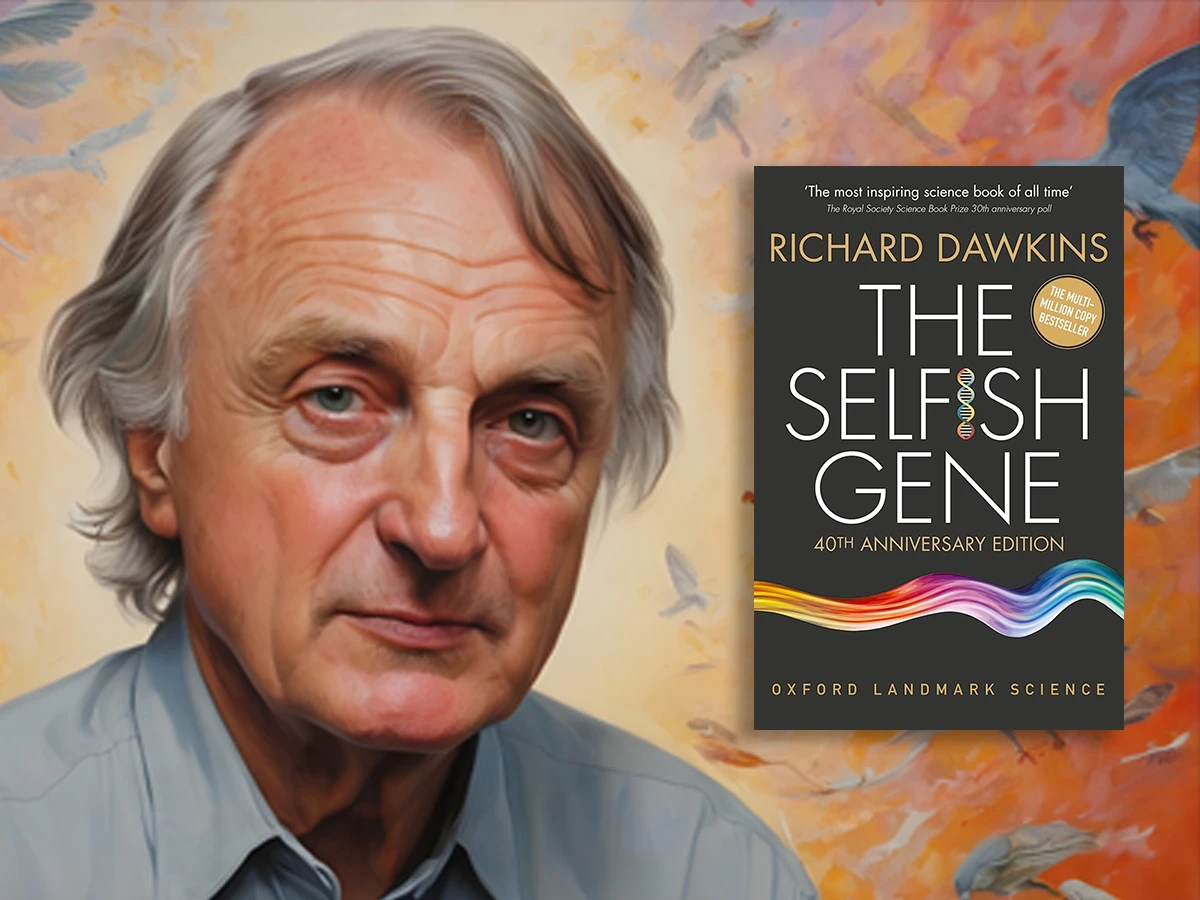The Selfish Gene by Richard Dawkins: Book Review & Insights

The concept of the “selfish gene” revolutionized the way we understand evolution and natural selection, thanks to Richard Dawkins’ seminal work, “The Selfish Gene,” first published in 1976.
In this book, Dawkins posits that the unit of selection in evolution is not the individual organism, nor the group or species, but the gene. This perspective shifts the focus of evolutionary strategy to the level of genes, competing for survival and replication across generations.
Dawkins’ theory has not only deepened our understanding of the biological world but also sparked debates across various disciplines, including psychology, sociology, and computer science.
I am intrigued by the possibilities of gene editing for our future, and this is the fourth book I read on the subject. Previously read – A Crack in Creation by Jennifer Doudna and Samuel H. Sternberg, Regenesis by Ed Regis and George Church, and The Code Breaker by Walter Isaacson.
This review, along with insights, quotes, and key takeaways, aims to delve into the essence of Dawkins’ argument, explore its implications, and assess its enduring influence on the scientific community and beyond.
The Premise of “The Selfish Gene”
At the heart of “The Selfish Gene” is the idea that genes are selfish entities, driven by the imperative to replicate themselves. Dawkins uses the term “selfish” not in a moral sense, but as a metaphor to describe the gene-centered view of evolution.
According to this view, organisms are mere “vehicles” or “survival machines” that genes build and use to ensure their survival and replication. This radical rethinking of the process of natural selection emphasizes that the behaviors of organisms, including altruism and cooperation, can be explained by the benefits they offer to the genes involved.
Insights and Key Takeaways
- Gene-Centered View of Evolution: Dawkins’ work underscores the power of looking at evolution from the perspective of genes. This viewpoint elucidates many complex biological phenomena, providing clear explanations for the existence of certain traits and behaviors.
- Altruism Explained: One of the most compelling arguments in the book is the explanation of altruistic behavior through the lens of genetic benefit. Dawkins introduces the concept of “kin selection” and the gene’s ability to promote behaviors that enhance the survival chances of related individuals, thereby ensuring the gene’s continuation.
- Extended Phenotype: Dawkins extends the concept of phenotype to include not just the physical body of an organism, but also the effects a gene has on its environment. This idea, further explored in Dawkins’ subsequent work, highlights the influence genes can exert beyond the organism, shaping ecosystems and behaviors.
- Meme Theory: In the final chapters, Dawkins introduces the concept of memes, or units of cultural transmission, drawing a parallel with genes in the realm of ideas and culture. This has opened up new avenues for understanding cultural evolution and has been influential in various fields.
- Impact on Biology and Beyond: “The Selfish Gene” has had a profound impact not only on evolutionary biology but also on psychology, economics, and computer science. Its ideas have been applied to understand complex systems, including the internet, market dynamics, and social behaviors.
Quotes and Meanings from “The Selfish Gene”
Richard Dawkins’ “The Selfish Gene” is rich with thought-provoking quotes that encapsulate its groundbreaking ideas and challenge conventional understandings of evolution, altruism, and the nature of life itself. Below, we explore some notable quotes from the book, delving into their meanings and the insights they provide into Dawkins’ theory.
“We are survival machines—robot vehicles blindly programmed to preserve the selfish molecules known as genes.”
This quote underscores the central thesis of the book: that organisms, including humans, exist primarily as vessels through which genes replicate themselves. It highlights the mechanistic and unconscious nature of survival and reproduction, suggesting that at a fundamental level, the complexity of life and behavior can be understood through the lens of gene propagation.
“The world is a battleground, and the replicators are the armies that fight it out.”
Here, Dawkins frames the process of evolution as a relentless struggle for survival and replication among genes, which he terms “replicators.” This militaristic analogy emphasizes the competitive aspect of evolution, where only the genes that can effectively use resources, including the bodies of organisms, to ensure their continuation will prevail.
“Let us try to teach generosity and altruism because we are born selfish.”
In this quote, Dawkins acknowledges the inherent self-interest encoded in our genes but advocates for the cultivation of altruistic and generous behaviors as a means to transcend our genetic predispositions. It reflects the nuanced view that, despite the selfish nature of genes, humans possess the capacity for cultural evolution that can promote societal well-being and cooperation.
“Genes are not conscious, they do not have goals or aims. But they behave as if they do.”
Dawkins clarifies that genes do not have desires or intentions in the way that conscious beings do. Instead, their “behavior” is the result of natural selection favoring genes that effectively replicate. This anthropomorphism helps readers understand the dynamic processes of evolution without implying that genes have a will or consciousness.
“The gene is the basic unit of selfishness and altruism.”
This succinct statement encapsulates the idea that altruistic behavior can be explained through the lens of genetic self-interest. Altruism, from this perspective, is not contradictory to selfishness at the genetic level but is instead a strategy that genes “use” to ensure their replication, particularly when it benefits genetically related individuals.
“Natural selection is a mechanism for generating an exceedingly high degree of improbability.”
Dawkins uses this quote to highlight the power of natural selection to produce complex organisms and behaviors from simple beginnings. It is a rebuttal to the argument that the complexity of life is too improbable to have arisen without a designer, emphasizing instead the cumulative power of natural selection over vast timescales.
“Our genes made us. We animals exist for their preservation and are nothing more than their throwaway survival machines.”
This quote reinforces the central theme of the book, viewing organisms as temporary carriers or “machines” that genes use for their survival. It emphasizes the transient nature of individual organisms in the broader context of genetic continuity.
Implications of the Selfish Gene Theory
The selfish gene theory, by shifting the focus of evolution to the level of genes, has profound implications for understanding biological and behavioral phenomena. It suggests that behaviors in animals and humans can often be better understood through the lens of gene survival. For example, the seemingly altruistic behavior of bees sacrificing themselves for the hive makes sense when one considers that they are helping to propagate their genes, shared by the hive’s queen.
By personifying genes as “selfish,” Dawkins not only provides a compelling narrative to explain complex biological phenomena but also challenges readers to reconsider their assumptions about life, cooperation, and the nature of human society.
Criticisms and Debates
Despite its significant influence, “The Selfish Gene” has not been without its critics. Some biologists argue that focusing exclusively on genes overlooks the importance of organism-level selection and environmental factors. Others have taken issue with the book’s interpretation of altruism, suggesting that Dawkins’ gene-centric view oversimplifies complex social behaviors.
- Group Selection Theory: Critics argue that group selection – where natural selection acts on groups, rather than individuals or genes can better explain certain cooperative behaviors. Dawkins, however, contends that any benefit to groups or species is a byproduct of gene-level selection.
- Cultural and Environmental Factors: Some scientists and scholars argue that Dawkins underestimates the role of culture, environment, and developmental processes in shaping behavior and evolution.
- Meme Theory Controversy: The concept of memes, while influential, has been criticized for its lack of empirical grounding and the difficulty of applying rigorous scientific methods to cultural evolution.
Dawkins’ Response and Subsequent Developments
Richard Dawkins has responded to many of these criticisms through his writings and public engagements, clarifying misconceptions and expanding on his theories. He has emphasized the explanatory power of the selfish gene concept while acknowledging the complexity of evolution and the multifaceted influences on behavior.
Broader Impact and Legacy
“The Selfish Gene” has left an indelible mark on how we think about evolution and ourselves. It has influenced fields beyond biology, including psychology, sociology, and computer science, providing a framework for understanding complex systems and behaviors. The book has also contributed to popular discussions on genetics and human nature, challenging us to reconsider our views on cooperation, competition, and the essence of life.
Frequently Asked Questions (FAQs)
What is the main argument of “The Selfish Gene”?
The book posits that the primary unit of selection in evolution is not the individual organism or species, but the gene itself. Organisms are viewed as vehicles that genes use to ensure their survival and replication.
How does “The Selfish Gene” explain altruistic behavior?
Dawkins explains altruism through the lens of genetic self-interest, particularly through concepts like kin selection, where genes promote behaviors that benefit related individuals carrying the same genes.
What is the significance of the term “selfish” in the context of the book?
“Selfish” is used metaphorically to describe genes’ drive to replicate themselves, not implying any conscious intent or moral judgment.
How did “The Selfish Gene” influence the field of evolutionary biology?
It shifted the perspective of evolutionary study to the gene level, offering new explanations for behavioral and evolutionary phenomena and sparking debates and further research.
What criticisms have been leveled against “The Selfish Gene”?
Critics argue that it oversimplifies complex behaviors, underestimates the role of group selection and environmental factors, and its concept of memes lacks empirical support.
What is the extended phenotype, as discussed in the book?
The extended phenotype refers to the idea that the influence of a gene can extend beyond the physical body of the organism it inhabits, affecting the environment and other organisms.
How does Dawkins address the concept of memes?
Memes are introduced as cultural analogues to genes, representing units of cultural transmission or ideas that replicate and evolve through human interaction.
What is kin selection, and how does it relate to altruism?
Kin selection is a form of natural selection that explains how altruistic behaviors can evolve when they benefit the reproductive success of relatives, thereby promoting the genes responsible for such behaviors.
How has “The Selfish Gene” impacted popular understanding of evolution?
It has popularized the gene-centered view of evolution, influencing how the public perceives natural selection, altruism, and the nature of biological life.
Can the ideas from “The Selfish Gene” be applied to human society and culture?
Yes, especially through the concept of memes, the book offers a framework for understanding cultural evolution and the spread of ideas.
What is gene-centered evolution, and why is it important?
Gene-centered evolution focuses on the role of genes in driving evolutionary processes, highlighting the importance of genetic competition and cooperation in shaping traits and behaviors.
How do genes influence behavior, according to Dawkins?
Genes influence behavior by coding for traits that enhance the survival and reproduction chances of the organism, which indirectly benefits the gene’s replication.
What role do memes play in cultural evolution?
Memes act as cultural replicators, spreading through imitation and variation, analogous to genetic transmission in biological evolution.
How does “The Selfish Gene” approach the concept of evolutionary stability?
It discusses evolutionary stable strategies as behaviors that, once adopted by a population, cannot be easily invaded by alternative strategies, emphasizing the role of genes in establishing these behaviors.
What implications does “The Selfish Gene” have for understanding human nature?
It suggests that many aspects of human behavior, including cooperation and competition, can be understood in the context of genetic self-interest and survival strategies.
How do critics view the applicability of “The Selfish Gene” to complex social behaviors?
Critics argue that complex social behaviors cannot be fully explained by gene-level selection and that Dawkins’ model overlooks the importance of culture, learning, and environmental influences.
What advancements in genetics and evolutionary biology have been influenced by “The Selfish Gene”?
The book has inspired research into genetic mechanisms of behavior, the nature of genetic replication, and the application of evolutionary principles to understanding human culture and society.
How does Dawkins defend “The Selfish Gene” against accusations of genetic determinism?
Dawkins clarifies that while genes influence behavior, they do not determine it in a fixed way; environmental interactions and chance also play significant roles.
What is the relevance of “The Selfish Gene” in contemporary discussions on genetics and evolution?
Its concepts continue to inform debates on genetic engineering, the nature of human behavior, and the ethical implications of our understanding of genetics.
How has the scientific community’s view of “The Selfish Gene” evolved?
While its core ideas remain influential, ongoing research and debates have nuanced the scientific community’s understanding of gene-centric evolution, incorporating more complex models of genetic and cultural evolution.
Conclusion and Reflections
Richard Dawkins’ “The Selfish Gene” has played a pivotal role in shaping contemporary understanding of evolution, genetics, and behavior. Its concepts, while controversial, have sparked a broad and ongoing dialogue across scientific disciplines and beyond, demonstrating the power of scientific inquiry to challenge and expand our understanding of the natural world. Through its exploration of the gene-centered view of evolution, it encourages us to reconsider what drives the diversity and complexity of life on Earth, offering insights that remain as relevant today as they were at the time of its publication.

Learner-in-Chief at Future Disruptor. A futurist, entrepreneur, and management consultant, who is passionate about learning, researching, experimenting, and building solutions through ideas and technologies that will shape our future.
Subscribe to the Future Disruptor newsletter.






Leave a Reply